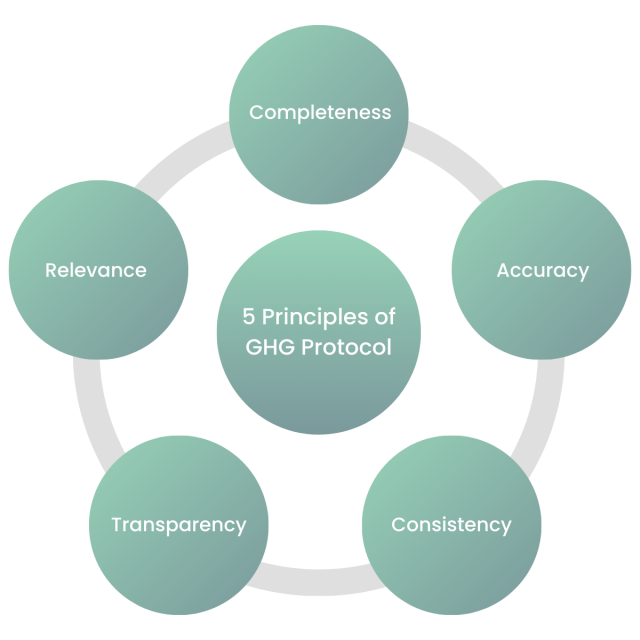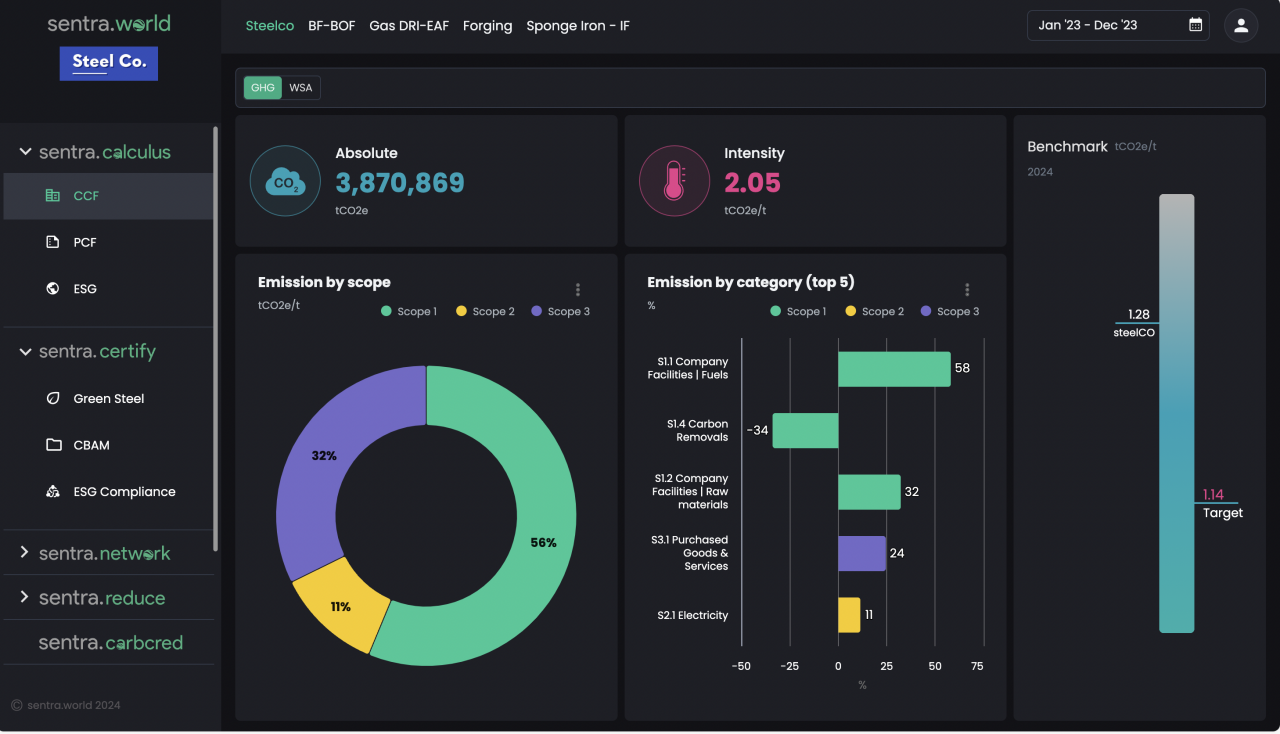In our rapidly changing world, the effects of climate change are becoming increasingly evident. As businesses and governments strive to reduce their impact on the environment, tools such as the Greenhouse Gas (GHG) Protocol have become essential for tracking and managing greenhouse gas emissions. The GHG Protocol plays a pivotal role in helping organisations align their emission reduction efforts with global climate goals, including those set by the Paris Climate Agreement, which aims to limit global warming to well below 2°C, with efforts to limit it to 1.5°C.
In this blog, we will explore:
- What is the GHG Protocol?
- Why is the GHG Protocol Important?
- Core Principles of the GHG Protocol for Effective Emissions Reporting
- Future Implications of GHG Protocol
- How sentra.world helps in GHG Calculations?
What is the GHG Protocol?
The GHG Protocol is a widely recognized accounting tool developed by the World Resources Institute (WRI) and the World Business Council for Sustainable Development (WBCSD) to help organizations and governments measure, manage, and report greenhouse gas emissions. It provides a standardized framework for calculating emissions from a variety of sources, including electricity consumption, transportation, and industrial processes. By using the GHG Protocol, entities can better understand their carbon footprint and identify opportunities for emissions reductions.
Why is the GHG Protocol Important?
With global temperatures rising and climate-related disasters becoming more frequent, such as the severe flooding in Kerala in 2018 and the heatwaves across North India, there is an urgent need to reduce greenhouse gas emissions. The GHG Protocol plays a crucial role by providing a consistent and transparent methodology for measuring emissions. This allows organizations to set emission reduction targets, track progress over time, and demonstrate their commitment to sustainability to stakeholders.
Additionally, the GHG Protocol helps facilitate international cooperation on climate action by providing a common language for reporting emissions. This standardization is essential for comparing emissions data across organizations and countries, enabling better-informed decision-making and policy development.
Core Principles of the GHG Protocol for Effective Emissions Reporting
The GHG Protocol is guided by five key principles: Relevance, ensuring the GHG inventory reflects the company’s emissions profile; Completeness, covering all emission sources within the boundary; Consistency, enabling meaningful comparisons over time; Transparency, with clear documentation of methodologies and assumptions; and Accuracy, ensuring reliable data without material misstatements. These principles provide a robust framework for accurate and consistent GHG accounting, essential for effective climate change strategies and reporting.

Current Values of the GHG Protocol
Since its inception in 1998, the GHG Protocol has become the most widely used accounting standard for greenhouse gas emissions worldwide. Thousands of organizations, including businesses, governments, and non-profit organisations, have adopted the GHG Protocol to measure and manage their emissions.
While the GHG Protocol is universally applicable, it recognizes that one size doesn’t fit all when it comes to emission reporting. That’s why it offers a range of different standards, each designed to meet the specific needs of organizations as per the situation. Let’s understand it in simple terms:
-
- Corporate Accounting and Reporting Standard
This is the foundation of the GHG Protocol and applies to all kinds of organizations. It’s like the very first step to understanding your emissions. It guides companies on how to measure and report GHG emissions from their operations (known as scope 1 and scope 2 emissions).
For example, if you run a manufacturing plant, this standard will help you calculate emissions from the fuel used in your machinery (scope 1) and from the electricity you buy to power the plant (scope 2).
- Corporate Value Chain (Scope 3) Standard
For many businesses, most emissions don’t come from their direct operations but from other activities along the value chain—like the transportation of goods, supplier activities, or even the use of their products by customers. The Scope 3 Standard helps organizations calculate these indirect emissions, which can be tricky but incredibly important.
Let’s say you’re a smartphone manufacturer. Scope 3 emissions would include the energy used by customers charging their phones and the raw materials your suppliers use to build components.
- GHG Protocol for Project Accounting
What if your company is doing a specific project aimed at reducing emissions? That’s where the Project Accounting Protocol comes in. This standard helps you measure the greenhouse gas reductions from individual projects, like installing solar panels, developing wind farms, or launching an energy efficiency initiative.
This standard ensures that companies, cities, or even entire countries can measure how much greenhouse gas they’ve reduced by switching to greener methods or technologies.
- Product Life Cycle Standard
If you want to know the carbon footprint of a specific product, this is the standard for you. The Product Life Cycle Standard helps companies measure the emissions produced throughout the life cycle of a product—from the extraction of raw materials to its eventual disposal or recycling.
For instance, a company making t-shirts can use this standard to measure how much CO2 is emitted during the growing of cotton, the manufacturing process, transportation, and even how much energy a customer uses to wash that shirt.
- City and Community-Scale GHG Emissions Protocol
Cities are responsible for a large portion of the world’s carbon emissions. The City and Community-Scale GHG Emissions Standard helps city governments measure and report emissions from all activities within their boundaries. This can include emissions from transportation systems, power generation, waste management, and more.
- GHG Protocol for Agriculture, Forestry, and Other Land Use (AFOLU)
This standard is geared toward industries related to land use, such as agriculture and forestry. It helps measure the carbon footprint of land management practices, like livestock farming, crop production, or forestry activities. AFOLU emissions are a significant part of global GHG emissions, so it’s vital for these sectors to have clear guidelines for measuring their impact.
Future Implications of the GHG Protocol
Looking ahead, the GHG Protocol will continue to play a key role in the global transition to a low-carbon economy. As countries implement more ambitious climate targets under the Paris Agreement, the demand for robust emissions accounting tools like the GHG Protocol will only increase.
In particular, the GHG Protocol is expected to evolve to address emerging challenges and opportunities in the transition to a sustainable future. This may include updates to reflect new scientific findings, changes in regulatory requirements, and advancements in technologies for measuring and reducing emissions.
Furthermore, the GHG Protocol is likely to become even more integrated with other sustainability frameworks, such as the Sustainable Development Goals (SDGs) and the Task Force on Climate-related Financial Disclosures (TCFD). This cross-pollination of reporting standards will enable organizations to better align their climate goals with broader sustainability objectives and financial risk management.
How sentra.world help in GHG Calculations?
sentra.world can play a pivotal role in supporting organizations in implementing the GHG Protocol by offering innovative solutions for greenhouse gas accounting and reporting. Through advanced data analytics, automation, and integrated platforms, sentra.world can streamline the process of tracking emissions across different scopes (1, 2, and 3), making it easier for businesses to monitor their carbon footprint and identify reduction opportunities. By providing real-time insights and comprehensive reports, sentra.world can enable organizations to not only comply with global standards but also drive meaningful progress toward their sustainability and climate goals. This contribution can further enhance transparency, foster accountability, and promote collaboration in the fight against climate change.

In conclusion, the GHG Protocol is a critical tool for organizations and governments seeking to address climate change and contribute to a more sustainable future. By accurately measuring and reporting greenhouse gas emissions, entities can take informed actions to reduce their impact on the environment and build resilience in the face of climate risks. As we look towards the future, the GHG Protocol will continue to be a guiding light in the transition to a low-carbon, resilient economy.


